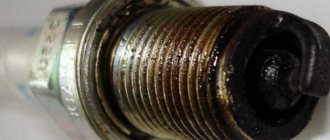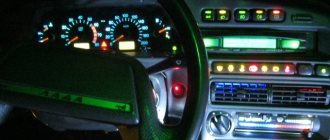When starting the engine when cold, thick smoke often appears coming out of the exhaust system. Smoke can have different shades from white to blue and even black. The smoking stops after the engine warms up, and may continue afterwards.
If a warm engine smokes, this means that the power unit has specific malfunctions. The color of the exhaust gases indicates the stage of development of the breakdown and its severity.
Brief description of the symptoms accompanying the release of smoke
In some cases, smoke may be accompanied by the following symptoms:
- difficulty starting a cold engine;
- unstable operation of the engine both at idle and under load;
- inconsistency of tachometer readings (speeds fluctuate);
- increased fuel and engine oil consumption;
- loss of power of the power unit.
There are often situations in which engine smoking is the only warning sign.
The design of the vehicle is designed for the system to constantly, unnoticeably release exhaust gases into the atmosphere in specified volumes. But if, when starting the engine, smoke comes out of the exhaust pipe in large quantities, it is necessary to urgently look for the cause of the alarming symptom that has appeared.
The first thing you need to pay attention to is the color, shades and density of the smoke coming from the engine. The most common colors of the gases released are:
Each of the listed smoke colors can have different shades, but this division into groups is the main one.
Causes of engine smoking
Why does the engine smoke? Car owners are often interested in this. The main malfunctions that cause increased smoke output from the exhaust pipe:
- damage occurring in the fuel supply system;
- wear of parts included in the cylinder-piston group;
- disturbances in the operation of the gas distribution mechanism;
- problems with the cooling system.
Smoke may appear when the quantitative air-fuel balance is disturbed, uneven mixing and incomplete combustion of the air-fuel mixture, or failures that occur when coolants or lubricants penetrate the combustion chambers.
Each of the reasons described can affect the shade of the smoke cloud emitted.
An experienced technician is able to take into account the impact of defects in one system on the incorrect operation of other components of the power unit. For example, problems that occur in the cooling system lead to overheating of engine components. Under the influence of ultra-high temperatures, the piston rings are destroyed, the seal is broken, oil and coolant penetrate the cylinders, burn, producing smoke of a certain color.
After capitalization, as a rule, the engine smoke stops.
Clear smoke from the exhaust pipe
The steam coming out of the engine can be mistaken for white smoke. Steam is formed during the evaporation of accumulated liquid in cooled engine systems. Most often, the accumulation of liquid at the end of the exhaust pipe and the release of steam are observed in the cold season after starting the engine.
The engine and exhaust system components heat up and water evaporates rapidly. After the engine and exhaust system have completely warmed up, the amount of steam is reduced to a minimum or disappears completely.
The amount of steam released depends on the humidity levels in the environment; the higher they are, the longer its traces will be visible. The release of steam is not a sign of breakdown of engine parts and components; if this effect occurs, repairs are not required.
Problem options
VAZ cars have many different problems, including frequent exhaust system and engine malfunctions. Most malfunctions of the ignition system, exhaust and engine components are accompanied by smoke. This happens for a variety of reasons. First you need to look at all the options when you don’t need to worry about the integrity of any of the systems.
Here is the first and main one: the engine starts, abundant white smoke begins to emit from the exhaust pipe.
This is quite normal.
But this does not bode well if no increase in fuel, oil or cooling fluid consumption has been noticed. Particularly thick vapor formation occurs after cold winters and long periods of machine downtime without operation.
White vapor is not dangerous, so there is no cause for concern.
Black smoke coming out
The greatest damage to the environment is caused by clouds of black smoke coming out of a car's exhaust pipe or directly from the power unit. The most likely reasons for the appearance of such smoke lie in the following violations:
- malfunctions of the engine control system;
- disorder of adjustments in fuel equipment;
- reducing engine cylinder compression.
An imbalance between the number of components of the air-fuel mixture in the direction of increasing fuel causes not only the formation of black smoke, but also significantly increases fuel consumption. Failure of the normal mixture formation process may be caused by contamination of the air filter. A deficiency of air entails an excess of fuel when preparing the air-fuel mixture.
A decrease in the compression level can be caused by mechanical damage to the cylinders, which significantly reduces the power of the power unit and contributes to an increase in the concentration of fuel in the mixture.
To carry out accelerated diagnostics, it is necessary to examine the condition of the spark plugs. Black deposits indicate that there is a need to replace spark plugs with new samples, followed by repair of deformed elements and regulation of power unit systems.
What is exhaust?
If your power unit and adjacent systems are in good working order and operating normally, then the exhaust is nothing more than a combination of water vapor, nitrogen and carbon dioxide. They are practically colorless; when a working unit is operating, an invisible stream of these gases flows from the pipe; a catalyst , which removes various gases at the outlet of the exhaust manifold.
But why does white smoke sometimes come out of the muffler? Does this occur especially in the mornings in cold weather? It's not always a malfunction, it's simple physics.
White smoke appears
An engine that smokes white gas does not always release harmless water vapor. White smoke is distinguished from steam by the following characteristics:
- increased smoke density;
- long-term dispersion;
- presence of a persistent burning odor;
- does not disappear when the engine warms up.
White thick smoke coming from the exhaust pipe of a car indicates a malfunction in the cooling system. The variety of shades of white smoke depends on the type of coolant used, but in any case, with such emissions, it is necessary to carry out urgent repairs to the engine cooling system.
Incorrect operation of the cooling system elements can lead to serious disruptions in the functioning of the power unit as a whole.
Causes of white smoke:
- cracks in the cylinder head (cylinder head);
- coolant entering the engine cylinder cavity;
- motor overheating;
- use of low quality coolant.
If the cylinder head seal is broken, the coolant penetrates into the cylinders and into the engine sump crankcase. When lubricants are diluted with antifreeze or antifreeze, the viscosity of the oil decreases, which significantly affects its functions.
Smoke with a bluish (gray) tint
If a diesel or gasoline engine smokes heavily with blue gas, this means that engine oil is leaking into one or more cylinders. During combustion, thick clouds of smoke are formed, which have a persistent smell of burnt oil and do not dissipate for a long time.
Depending on the type of motor oil used and the ambient temperature conditions, the color of the smoke may have different intensities of blue. To give a more accurate assessment of the nature of the smoke coming out and distinguish it from standard exhaust, it is necessary to regularly check the oil level. Excessive consumption of machine lubricant indicates the presence of leaks.
In addition to visual analysis of the color of the exhaust gases, a check is carried out using paper attached to the exhaust pipe. If distinct spots of an oily nature remain on the sheet, then the reason for the release of bluish smoke with a bluish tint from the chimney becomes clear: the presence of oil in the combustion chamber.
What to do if the engine smokes when cold
Many new car owners ask what to do if the engine smokes when cold. I advise you to first see how it will behave when it warms up. If it continues to smoke when hot, then immediately take such a motor to a service center for repairs.
If it stops smoking, be sure to look at the color of the smoke next time. The shade depends on the breakdown of parts in the internal combustion engine. If there are any changes in the direction of enhancing the color scheme, or the smoke turns blue or black, then I recommend going to a service center. If it remains transparent, then nothing needs to be done.
If you are well versed in the insides of the engine, you can independently diagnose the rings and cylinders. Check if the air filter is clogged. Cylinder diagnostics are carried out as follows:
There are many other ways, but I still recommend contacting experienced mechanics.
Description of the reasons for the appearance of white smoke with a blue tint
Why does the engine smoke white gas with a bluish or blue tint? When researching the origin of gray or blue exhaust, the following reasons are most often cited:
- Damage to valve stem seals.
- The occurrence of rings designed to remove residual oil from the cylinder walls.
- Turbocharger malfunction.
- The oil used is of low quality.
The purpose of the caps is to hold the oil before it is supplied. Poor quality and malfunction of these elements lead to loss of tightness; lubricant constantly leaks and accumulates in the cylinders. As soon as you start a cold engine after a long break, the accumulated oil will burn together with the fuel in the chamber, blue or dark blue smoke will burst out of the car’s exhaust pipe in a huge cloud.
Wear and sticking of oil scraper rings leads to excess lubricant entering the engine cylinders and subsequent combustion. The use of the ring decarbonization method temporarily solves the problem, but in this case the rings lose their elasticity, and the occurrence may resume. To avoid serious damage to the power unit, it is necessary to constantly monitor the color of the exhaust gases.
With little wear of engine elements, a short-term release of blue smoke is observed during cold operation. As the motor heats up, the parts expand as a result of an increase in their temperature, which has a beneficial effect on the gaps between the mating surfaces of the elements. The smoke output decreases or disappears altogether.
Why does it smoke when cold?
It happens that smoke appears during startup due to breakdowns in one engine unit, which arose due to faults in another part of the engine. For example, if the power unit has poor cooling and experiences constant overheating, then the piston rings burn.
In other cases, the engine smokes due to:
Of course, only an experienced mechanic will determine the exact cause of the problem, so I always advise those who have little knowledge of engines to contact a service station in any case when the car begins to behave strangely. This will save you from further problems with it and high financial expenses.
The engine emits white smoke
White smoke is more like steam. Therefore, when you turn on the power plant, if the engine floats with a whitish, almost transparent steam, especially in winter, then there is no need to worry. When the engine starts to warm up, there is still condensation in the exhaust pipe. When it heats up, the moisture begins to warm up and evaporate. Therefore, you may notice whitish steam coming out.
Attention! When the temperature outside drops below 20 degrees, this white steam can become thick.
If the engine emits white smoke when you start the car in the summer season, then something is happening inside the engine, most likely there is a malfunction. Perhaps the CPG is suffering. This is where antifreeze comes in. This phenomenon indicates a leak in the rubber covering the cylinder head.
Water from the cooler does not evaporate quickly. This causes the appearance of white exhaust gases. By the way, when it comes out of the exhaust pipe and dissolves in the atmosphere, you can see a small bluish cloud.
To check on your own without contacting service whether the problem lies in a broken gasket, you need to open the radiator neck. If you smell the exhaust fumes and see a film of grease on the surface of the antifreeze, then the problem is indeed in the gasket.
The engine emits blue smoke
When the engine emits blue smoke, the cylinders are broken. Only now the bluish smoke indicates that lubricant has entered the cylinders, and not antifreeze. This kind of smoke, also called oily, can be of the following shades:
If your car emits bluish smoke when cold, you should immediately take the car in for repairs. Since further driving will only be to the detriment of the engine.
Attention! How to distinguish bluish smoke from steam, which also leaves a bluish cloud: the bluish cloud does not dissipate after it leaves the chimney. And there is one more problem. Nowadays, many engines have converters that remove lubricant from the exhaust gases. This is bad because the car owner will not be able to see the symptoms of the vehicle's illness and drive it until the engine knocks.
You can only check by placing paper near the pipe outlet with the motor turned on recently. With the gas from the exhaust, drops of unburned lubricant will fall onto the sheet.
The engine smokes black smoke
If the power plant smokes black, then the combustible mixture is highly enriched. And, if high enrichment occurs, then there is a breakdown in the fuel supply system. When the engine smokes black, there is usually also excessive fuel consumption. The engine is difficult to start and sometimes stalls after starting. The car loses its former power.
In carburetor power units this happens due to overkill in the float chamber. In such engines, the needle valve has some kind of malfunction and does not work adequately.
Most often, car owners simply have a clogged air filter device. In this case, the engine smokes black. They come to a car service when the problem begins to worsen.
The engine smokes white smoke with a blue tint
If the power plant smokes whitish with a blue tint, then the fault lies in the valve stem seals. The parts become dull and do not perform their function. Another reason may be faulty oil scraper rings. They usually wear out and become stuck and do not perform their function.
When the engine emits blue smoke, the lubricant most often begins to burn. As for turbocharged engines, the problem lies in the breakdown of the turbocharger. There may also be problems with crankcase gas recirculation. Usually it gets clogged.
Turbocharger and causes of bluish smoke
If the car is equipped with a turbocharger, then the output of thick bluish smoke may be due to its unsatisfactory condition. As a result of a malfunction of this unit, engine oil designed to lubricate the turbine bearings leaks. The lubricant penetrates the engine starting system.
During the combustion of turbocharger oil, thick bluish smoke is formed, causing irreparable harm to the atmosphere.
To diagnose the turbine, you must perform the following steps:
- Disconnect the turbine from the engine.
- Check for oil accumulation inside the air duct.
The accumulation of large amounts of oil in the air duct and turbine is a serious defect. If you discover such a situation, you must immediately seek qualified assistance from a service center.
The influence of the quality of the oil used on smoke formation
Motor oil must have certain characteristics. The quality of the lubricant used directly depends on its properties. If the car engine contains low-quality oil, the viscosity coefficient of which does not correspond to the car brand, or if the temperature inside the engine increases, a sharp loss of useful properties of the lubricant occurs, this leads to serious damage to the elements and systems of the power unit. If blue smoke appears, you need to check the oil for compliance and, if necessary, completely replace it.
The appearance of smoke can be caused by a number of other reasons - from the appearance of microcracks in the engine body to the use of the wrong type of fuel intended for a given engine brand. Each specific situation always has a solution when seeking help from qualified specialists.
- Posts: 10
- From: Tatarstan
May 7, 2013, 1:57 pm #1 123
tell me, what is it? on a well-warmed-up engine there is white smoke (steam) xs, on a cold one there is no such thing, there is but within the normal range, just condensation, after warming up it is also normal, it appears after a sharp drive, it sits for 3 hours - you start it too. car VAZ21124 1.6 16v, gas equipment installed
- Posts: 97
- From: Orenburg
May 7, 2013, 2:06 pm #2 123
When I was driving the 412, brake fluid leaked from under the gasket on the Muscovite directly onto the hot distributor. There was a beautiful plume of white smoke, everyone was looking around. The brakes ran out, and I, honking desperately, stopped the car using a pile of gravel on the side of the road.
- Posts: 10
- From: Tatarstan
7 May 2013, 14:13 #3 123
with the brakes everything is fine, I've been driving it for a month, this hasn't happened to me, it started today
- Posts: 372
- From: Zelenodolsk
- Haima 3 Sedan
May 7, 2013, 5:24 pm #4 123+ 3
White smoke from the muffler appears when coolant enters the engine cylinders. The head gasket is most likely leaking. Check the coolant level. Is it present in the oil?
- Posts: 10
- From: Tatarstan
May 7, 2013, 5:55 pm #5 123
Vardos today, 17:24 #4
White smoke from the muffler appears when
coolant getting into
engine cylinders. Leaking
Filters
You know, the last reason could be faulty (clogged) engine air filters. I also thought that this was not possible - but it is a fact! The thing is that there is less air (dirty filters do not allow it to pass), but there is more fuel, and the “smoke” increases. But here, not only white but also black exhaust can appear. But this is a topic for another article, be sure to follow our blog.
In the end, I want to say - if you have such a “whitish fog” effect in winter, the fluid level does not drop, then this is normal! You shouldn't even pay attention to this.
I hope you liked the article, if so, then tell us about us on social networks, this is the biggest reward for us.
( 53 votes, average: 4.45 out of 5)
White smoke from the exhaust
As I already said, in the cold season, on almost any car you can see white smoke from the exhaust, which is not a sign of a malfunction and does not require any action on the part of the owner. The white smoke from the exhaust will disappear as soon as it warms up.
If thick white smoke comes out of the exhaust and the temperature outside is above zero, this is a reason to think about it. Most likely, antifreeze gets into the cylinders, and there are cracks or leaking gaskets in the cylinder head itself.
Gray smoke with a blue tint from the exhaust
Gray or blue smoke usually indicates an oil problem. Often, blue smoke from the exhaust pipe is observed in cars whose engines “take oil.” The blue or gray color itself occurs as a result of oil entering the combustion chamber and its subsequent combustion. Excess oil in the combustion chamber indicates wear of parts of the cylinder-piston group; these could be: problems with valve stem seals, worn rings or problems with the cylinders themselves, as well as problems in the crankcase ventilation system. The appearance of blue smoke will one way or another be accompanied by increased engine oil consumption, decreased compression, and a drop in engine power.
I note that blue smoke is not always the wear of the piston rings; it can also be a “stagnation” as a result of their coking. I advise you to familiarize yourself in more detail with the term “engine coking”, as well as how to decoke it.
Black smoke from the exhaust
As a rule, the appearance of black smoke from the exhaust indicates bad fuel. Blackness is essentially soot that occurs as a result of incomplete combustion of fuel. There may be many reasons for this, but the main one is considered to be the low quality of the fuel, as well as the presence of a large amount of soot-forming substances in its composition. Even though in modern fuel systems the process of fuel formation is handled by electronics, which can “smartly” organize the work of all components involved in this process, poor fuel, especially diesel, will one way or another “smoke like a child.”
Also, often the reasons lie in the following:
- Carburetor malfunction, adjustment required;
- Incorrect spark plug gap or faulty spark plugs themselves;
- Clogged exhaust system, problems with the catalyst;
- Irregularities in the operation of the valves; valve adjustment is necessary;
- Problems with injectors (injectors need to be washed).
In rare cases, the reasons for the appearance of black smoke from the exhaust may be associated with malfunctions of the “electronics,” which is easy to find out by connecting a diagnostic scanner to the “brains.”
Tips for proper engine break-in
Firstly, let’s discard attempts to use the ECO mode with an automatic transmission: in order to save fuel, the transmission will engage high gears as early as possible! Sport mode, on the contrary, can be used, but there won’t be much difference with or without it. We are not going to spin the engine above 2500 rpm.
Let it be better “Sport”
A lean mixture is not needed during break-in. So it’s better not to use the ECO mode with a manual transmission... In general, after a major overhaul
It will be easy to break in the engine: you need to do everything that you would do after buying a new car with the same engine.
The break-in period is usually 2000-2500 km.











